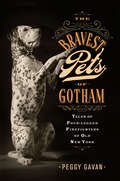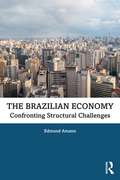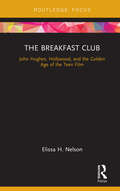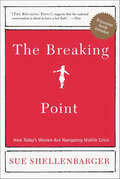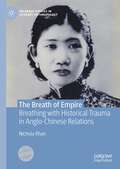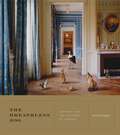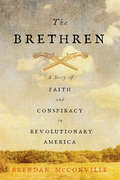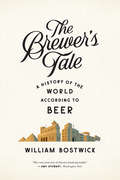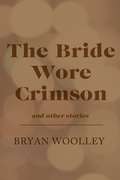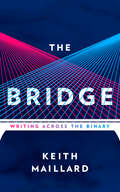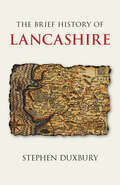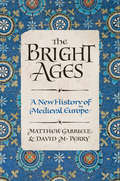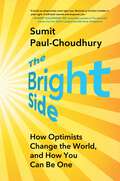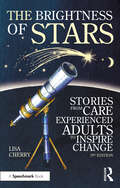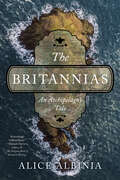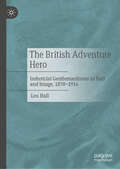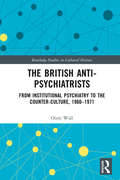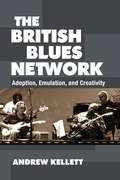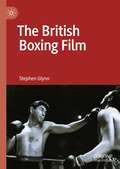- Table View
- List View
The Bravest Pets of Gotham: Tales of Four-Legged Firefighters of Old New York
by Peggy GavanIn the late 1800s and early 1900s, the New York Fire Department permitted firemen to keep one dog, one cat, or singing birds in their firehouse. Since the firemen were required to live and work at the firehouse full-time, these animal mascots—along with the horses that pulled the fire trucks—were their constant companions, making a dangerous workplace feel more like home. The Bravest Pets of Gotham takes readers on a fun historical tour of Old New York, sharing touching and comical stories about the bond between FDNY firefighters and their four-legged or feathered friends. The book contains more than one hundred astonishing, emotional, and sometimes hilariously absurd tales of the FDNY animal mascots whose extraordinary intelligence, acts of bravery, and funny antics deserve to be remembered. Some anecdotes depict fire companies that broke the one-pet rule and welcomed a veritable menagerie of animals into their firehouses, including goats, turtles, and even monkeys. Whether you are an animal lover, a history buff, or a fan of firefighting, The Bravest Pets of Gotham is full of stories that will thrill and amuse you.
The Brazilian Economy: Confronting Structural Challenges
by Edmund AmannThe Brazilian economy has long been defined by its enormous potential. Over the past 30 years, some of this has at last been realised. Latin America’s largest economy has rapidly risen in global importance while poverty at home has declined. Yet, despite periods of progress, Brazil remains prone to economic crisis. It is also beset with stubborn inefficiencies and income disparities. This book considers the structural challenges which will need to be overcome if Brazil is to break with the past and finally embark on a path of sustained, inclusive growth. This book aims to give the reader a clear knowledge of the nature of these structural challenges, why they exist and the effectiveness of attempts to overcome them. Through this, readers will gain a deep understanding of the contemporary Brazilian economy. The challenges discussed fall into three areas: those centring on competitiveness and the supply side, those arising from critical macroeconomic issues and those connected with environmental sustainability and social inclusion. This volume systematically examines each of these domains, highlighting such vital topics as export competitiveness, human capital formation, environmental policy and the role of financial market reform. Where appropriate, this book sets Brazil’s experience in an international comparative context. It points out that many of the challenges faced by Brazil are shared by other emerging economies. In this sense, the policy lessons which stem from this volume have broader international relevance. This book will be vital reading for all those seeking in-depth understanding of one of the world’s most important, yet troubled, economies. This readership is likely to include undergraduate and postgraduate students on development economics and Latin American area studies programmes, policymakers wanting an up-to-date and coherent analysis of Latin America’s largest economy, and financial professionals.
The Bread Makers: The Social and Professional Lives of Bakers in the Western Roman Empire
by Jared T. BentonBread was the staple of the ancient Mediterranean diet. It was present in the meals of emperors and on the tables of the poorest households. In many instances, a loaf of bread probably constituted an entire meal. As such, bread was both something that unified society and a milieu through which social and ethnic divisions played out. Similarly, bakers were not a monolithic demographic. They served both the rich and the poor, but some bakers clearly operated within regional traditions. Some lived in big cities and others lived in small towns. Some bakers made flat breads and others made leavened loaves. Some made coarse brown loaves and others specialized in fancier white breads. This book offers new methods and new ways of framing bread production in the Roman world to reveal the nuances of an industry that fed an empire. Inscriptions, Roman law, and material remains of Roman-period bakeries are combined to expose the cultural context of bread making, the economic context of commercial baking, the social hierarchy within the workforces of bakeries, and the socio-economic strategies of Roman bakers.
The Breakfast Club: John Hughes, Hollywood, and the Golden Age of the Teen Film (Cinema and Youth Cultures)
by Elissa H. NelsonThe Breakfast Club is a quintessential teen film. This book analyzes how multiple factors coalesced to solidify the status of The Breakfast Club as one of the most emblematic films of the 1980s and one of the most definitive teen films of the genre. The film brings together genre-defining elements – the conflicts between generations and peer pressure, archetypical characters and breaking down stereotypes, the celebration and survival of adolescence, and the importance of this time in life on the coming-of-age process – and became a significant moment for John Hughes as an auteur and for teen films in the 1980s. More than just embodying these elements of the genre, filmmaker Hughes and the Brat Pack stars helped introduce and popularize multiple generic features that would come to be expected with the teen film formula. The content of the film combined with its context of production in the middle of a boom in teen filmmaking in Hollywood. Meanwhile, the marketing that focused on contemporary music, peer group dynamics, and oppositions between Generation X and baby boomers, merged with an enthusiastic reception by youth audiences. Its endurance speaks to the way the film’s level of importance as a critical, commercial, and influential film with tremendous impact has grown since its initial debut.
The Breaking Point: How Today's Women Are Navigating Midlife Crisis
by Sue Shellenbarger"[The Breaking Point] suggests that the national conversation is about to have a hot flash. The passage through middle age of so large a clump of women . . . guarantees that some rules may have to be rewritten and boundaries moved to accommodate them." -Time magazine From the cover of Time to Desperate Housewives, the phenomenon of women in midlife experiencing a period of tumultuous personal upheaval-a breaking point-has reached a peak in our culture. Today, more than 15 million baby boomer women report having a midlife crisis compared to 14 million men. In The Breaking Point, Wall Street Journal columnist Sue Shellenbarger looks beyond the numbers to discover the root of all this angst and examine the ways, both successful and not, that women are navigating this crucial transition period. Drawing on original research data and interviews with more than fifty women, The Breaking Point uses real-life stories to illustrate the different archetypes and modes the course of reinvention follows. The book also shows women how to avoid the pitfalls of a midlife meltdown-ruined relationships and jettisoned careers-and instead transform this turbulent time into a period of personal growth that will enrich the rest of their lives. Once every decade or so a book comes along that defines the collective experience of an entire generation. Provocative, insightful, and resonant, The Breaking Point is just such a book."Every once in a while you read a book that transforms you. Like the shift of a kaleidoscope, it reconfigures your view of life's journey. This is such a book. It may stimulate you to change directions, perhaps even enable you to find life's greatest joy: fulfillment. An invigorating read."-Helen Fisher, author of Why We Love"This catchy work is tailor-made for the 36 percent of women who will eventually have what they regard as midlife crises' . . . an illuminating guide." -Publishers Weekly
The Breath of Empire: Breathing with Historical Trauma in Anglo-Chinese Relations (Palgrave Studies in Literary Anthropology)
by Nichola KhanThis Palgrave Pivot combines anthropological, biographical and autoethnographic perspectives onto imperial intimacies, the transgenerational transmission of colonial and familial trauma, and violence in two kinds of household: the Chinese family in British Hong Kong and wider imperial Asia, and the Anglo-Chinese family in England. Conjoining approaches from literary anthropology, the historiography of Anglo-Chinese relations, and perspectives on colonial trauma, it highlights the relative neglect of women’s stories in customary Chinese readings, colonial accounts, and an ancestral family record from 1800 to the present. Offering an alternative view of family history, this book links the body as a dwelling for assaults on the ability to breathe—through tuberculosis, opium smoking, asthma, and panic—with the physical home that is assaulted in turn by bombs, killing, intimate betrayals, and fatal respiratory illness. The COVID-19 “pandemic of breathlessness” serves as mnemonic both for state repression, and for the reprisal of historical fears of suffocation and dying. These phenomena converge under an analytic concept the author calls respiratory politics.
The Breathe Life Holy Bible: Faith in Action (NKJV)
by Thomas NelsonFaith in Action: Being a Gospel-Driven Change-MakerChristians are called to be the hands and feet of Jesus in the world. To be proclaimers of good news—agents of reconciliation with a message of hope, and faith that takes action. We need wisdom from God&’s Word, power from His Spirit, hope from His gospel, and faith that He will equip us for the task. The Breathe Life Bible invites you to experience Scripture through the lens of the BREATHE acronym: Believe, Reconcile, Exalt, Act, Trust, Hope, and Elevate. Receive practical biblical encouragement. Find answers to some of life&’s most difficult situations. Discover what faith in action really looks like as we pursue God&’s vision of being a community where all people are valued and cared for.Features include: Introduction article by Rev. Dr. Bernice A. KingForeword by Ambassador Andrew YoungPrayer of dedication by Bishop Hezekiah WalkerEncouragement letters from Rev. Matthew Wesley Williams (President, Interdenominational Theological Center), Dr. Thelma Thomas Daley (President, National Council of Negro Women), and Derrick Johnson (President, NAACP)The Sky Dive more deeply into faith in action with these three focused articles. Through God&’s Word, you are empowered to live a fruitful, abundant life, fully engaged in the pursuit of healthy relationships with God and others.The Air Increase your understanding with introductions and overviews for each book of the Bible&’s content and themes, plus insights on each book&’s relevance to the hearts of people of color today.We Speak Look at life through the eyes of 49 people in the Bible. Relate to the joys, sorrows, victories, and defeats of those who lived long ago and glean insights on how to live today.Life Support Explore how God&’s truth can be applied to action steps in your life through 10 passages in the Bible.Inhale-Exhale A Q&A format addresses some of the most difficult life situations with answers that remind you that it is possible to rise above challenges in God&’s power.#Oxygen Be challenged and encouraged with 98 brief snippets of wisdom drawn straight from the Word.Release Focus on tenets of the BREATHE acronym—Believe, Reconcile, Exalt, Act, Trust, Hope, Elevate—through this series of 49 devotions developed by Christian pastors and teachers who seek hope and guidance in God&’s Word.Cross references and concordanceWords of Christ in redClear and readable 10-point NKJV Comfort Print®Additional Contributors:Dr. Charrita Danley QuimbyRev. Dr. Eric W. LeeMichele Clark JenkinsStephanie Perry MooreMin. Derrick MooreBishop Kenneth UlmerDr. Arthur SatterwhitePastor Debra B. MortonPastor Tommy KyllonenRev. Dr. Helen DelaneyPastor Tommy StevensonBishop Vashti McKenzieBishop Marvin SappDr. Franklin Perry, Sr.Rev. Dr. LaKeesha WalrondAntonio Neal PhelonElder De&’Leice R. DraneS. James GuitardDr. Lakeba H. WilliamsRev. Dr. Walter L. KimbroughJekalyn CarrFirst Lady Jamell Meeks
The Breathless Zoo: Taxidermy and the Cultures of Longing (Animalibus)
by Rachel PoliquinFrom sixteenth-century cabinets of wonders to contemporary animal art, The Breathless Zoo: Taxidermy and the Cultures of Longing examines the cultural and poetic history of preserving animals in lively postures. But why would anyone want to preserve an animal, and what is this animal-thing now? Rachel Poliquin suggests that taxidermy is entwined with the enduring human longing to find meaning with and within the natural world. Her study draws out the longings at the heart of taxidermy—the longing for wonder, beauty, spectacle, order, narrative, allegory, and remembrance. In so doing, The Breathless Zoo explores the animal spectacles desired by particular communities, human assumptions of superiority, the yearnings for hidden truths within animal form, and the loneliness and longing that haunt our strange human existence, being both within and apart from nature.
The Breathless Zoo: Taxidermy and the Cultures of Longing (Animalibus: Of Animals and Cultures #1)
by Rachel PoliquinFrom sixteenth-century cabinets of wonders to contemporary animal art, The Breathless Zoo: Taxidermy and the Cultures of Longing examines the cultural and poetic history of preserving animals in lively postures. But why would anyone want to preserve an animal, and what is this animal-thing now? Rachel Poliquin suggests that taxidermy is entwined with the enduring human longing to find meaning with and within the natural world. Her study draws out the longings at the heart of taxidermy—the longing for wonder, beauty, spectacle, order, narrative, allegory, and remembrance. In so doing, The Breathless Zoo explores the animal spectacles desired by particular communities, human assumptions of superiority, the yearnings for hidden truths within animal form, and the loneliness and longing that haunt our strange human existence, being both within and apart from nature.
The Brethren: A Story of Faith and Conspiracy in Revolutionary America
by Brendan McConvilleThe dramatic account of a Revolutionary-era conspiracy in which a band of farmers opposed to military conscription and fearful of religious persecution plotted to kill the governor of North Carolina. Less than a year into the American Revolution, a group of North Carolina farmers hatched a plot to assassinate the colony’s leading patriots, including the governor. The scheme became known as the Gourd Patch or Llewellen Conspiracy. The men called themselves the Brethren. The Brethren opposed patriot leaders’ demand for militia volunteers and worried that “enlightened” deist principles would be enshrined in the state constitution, displacing their Protestant faith. The patriots’ attempts to ally with Catholic France only exacerbated the Brethren’s fears of looming heresy. Brendan McConville follows the Brethren as they draw up plans for violent action. After patriot militiamen threatened to arrest the Brethren as British sympathizers in the summer of 1777, the group tried to spread false rumors of a slave insurrection in hopes of winning loyalist support. But a disaffected insider denounced the movement to the authorities, and many members were put on trial. Drawing on contemporary depositions and legal petitions, McConville gives voice to the conspirators’ motivations, which make clear that the Brethren did not back the Crown but saw the patriots as a grave threat to their religion. Part of a broader Southern movement of conscription resistance, the conspiracy compels us to appreciate the full complexity of public opinion surrounding the Revolution. Many colonists were neither loyalists nor patriots and came to see the Revolutionary government as coercive. The Brethren tells the dramatic story of ordinary people who came to fear that their Revolutionary leaders were trying to undermine religious freedom and individual liberty—the very causes now ascribed to the Founding generation.
The Brewer's Tale: A History of the World According to Beer
by William BostwickWinner of 2014 U.S. Gourmand Drinks Award Taste 5,000 years of brewing history as a time-traveling homebrewer rediscovers and re-creates the great beers of the past. The Brewer's Tale is a beer-filled journey into the past: the story of brewers gone by and one brave writer's quest to bring them--and their ancient, forgotten beers--back to life, one taste at a time. This is the story of the world according to beer, a toast to flavors born of necessity and place--in Belgian monasteries, rundown farmhouses, and the basement nanobrewery next door. So pull up a barstool and raise a glass to 5,000 years of fermented magic. Fueled by date-and-honey gruel, sour pediococcus-laced lambics, and all manner of beers between, William Bostwick's rollicking quest for the drink's origins takes him into the redwood forests of Sonoma County, to bullet-riddled South Boston brewpubs, and across the Atlantic, from Mesopotamian sands to medieval monasteries to British brewing factories. Bostwick compares notes with the Mt. Vernon historian in charge of preserving George Washington's molasses-based home brew, and he finds the ancestor of today's macrobrewed lagers in a nineteenth-century spy's hollowed-out walking stick. Wrapped around this modern reportage are deeply informed tales of history's archetypal brewers: Babylonian temple workers, Nordic shamans, patriots, rebels, and monks. The Brewer's Tale unfurls from the ancient goddess Ninkasi, ruler of intoxication, to the cryptic beer hymns of the Rig Veda and down into the clove-scented treasure holds of India-bound sailing ships. With each discovery comes Bostwick's own turn at the brew pot, an exercise that honors the audacity and experimentation of the craft. A sticky English porter, a pricelessly rare Belgian, and a sacred, shamanic wormwood-tinged gruit each offer humble communion with the brewers of yore. From sickly sweet Nordic grogs to industrially fine-tuned fizzy lager, Bostwick's journey into brewing history ultimately arrives at the head of the modern craft beer movement and gazes eagerly if a bit blurry-eyed toward the future of beer.
The Bride Wore Crimson and Other Stories
by Bryan WoolleyA new collection of "true Texas stories" to stand alongside his earlier collection, The Edge of the West and Other Texas Stories, including such portrayals of Texas and Texans as:--The title story on his own family scandal about his uncle being charged with the murder of his new bride;--The quest for the $65,000 prize fish in the Lake Texoma Crappiethon; and 17 other stories.
The Bridge: Writing Across the Binary
by Keith MaillardOne writer's deeply compelling story of growing up nonbinary in the 1940s and '50sAs a child, Keith Maillard asked his mother and grandmother, over and over again, "Am I a boy, or am I a girl?" Neither "boy" nor "girl" quite fit. But there were no other options. In this stunning memoir, Maillard creates an intricate collage of childhood memories, exploring the contradictory and destructive forces at work that put his very life at risk. For young Keith, writing proved to be a way to fight against what the world was telling him. In his scribbled stories, he began to spot the faintest glimmer that things could be different. And he kept fighting for years -- decades -- until he found a new understanding of his own nonbinary identity. The Bridge reveals the dangers of the gender binary, both for those who are outside it and for those who aren't. And it offers hope for a kinder future for all who dare to say "no" to the way that we do gender.
The Brief History of Lancashire
by Stephen DuxburyThe Brief History of Lancashirestarts, as all good histories should, with the beginning – the moment when the detritus of a dying star, spinning through the depths of the Milky Way, began to cool and coalesce, and rain – typically for Lancashire – began to fall as the moisture in the new atmosphere began to condense. A planet was formed, and history as we know it had begun. Racing through the history of Lancashire, with Neolithic residents, Romans, Civil War victories and Victorians – and, of course, a few cotton mills along the way – this delightful book will tell you everything you ought to know about the dramatic and fascinating history of the county – and a few things you never thought you would.
The Bright Ages: A New History of Medieval Europe
by David M. Perry Matthew Gabriele"Traveling easily through a thousand years of history, The Bright Ages reminds us society never collapsed when the Roman Empire fell, nor did the modern world did wake civilization from a thousand year hibernation. Thoroughly enjoyable, thoughtful and accessible; a fresh look on an age full of light, color, and illumination." —Mike Duncan, author of Hero of Two Worlds: The Marquis de Lafayette in the Age of Revolution A lively and magisterial popular history that refutes common misperceptions of the European Middle Ages, showing the beauty and communion that flourished alongside the dark brutality—a brilliant reflection of humanity itself.The word “medieval” conjures images of the “Dark Ages”—centuries of ignorance, superstition, stasis, savagery, and poor hygiene. But the myth of darkness obscures the truth; this was a remarkable period in human history. The Bright Ages recasts the European Middle Ages for what it was, capturing this 1,000-year era in all its complexity and fundamental humanity, bringing to light both its beauty and its horrors. The Bright Ages takes us through ten centuries and crisscrosses Europe and the Mediterranean, Asia and Africa, revisiting familiar people and events with new light cast upon them. We look with fresh eyes on the Fall of Rome, Charlemagne, the Vikings, the Crusades, and the Black Death, but also to the multi-religious experience of Iberia, the rise of Byzantium, and the genius of Hildegard and the power of queens. We begin under a blanket of golden stars constructed by an empress with Germanic, Roman, Spanish, Byzantine, and Christian bloodlines and end nearly 1,000 years later with the poet Dante—inspired by that same twinkling celestial canopy—writing an epic saga of heaven and hell that endures as a masterpiece of literature today. The Bright Ages reminds us just how permeable our manmade borders have always been and of what possible worlds the past has always made available to us. The Middle Ages may have been a world “lit only by fire” but it was one whose torches illuminated the magnificent rose windows of cathedrals, even as they stoked the pyres of accused heretics. The Bright Ages contains an 8-page color insert.
The Bright Continent: Breaking Rules & Making Change in Modern Africa
by Dayo Olopade&“For anyone who wants to understand how the African economy really works, The Bright Continent is a good place to start&” (Reuters). Dayo Olopade knew from personal experience that Western news reports on conflict, disease, and poverty obscure the true story of modern Africa. And so she crossed sub-Saharan Africa to document how ordinary people deal with their daily challenges. She found what cable news ignores: a continent of ambitious reformers and young social entrepreneurs driven by kanju—creativity born of African difficulty. It&’s a trait found in pioneers like Kenneth Nnebue, who turned cheap VHS tapes into the multimillion-dollar film industry Nollywood. Or Ushahidi, a technology collective that crowdsources citizen activism and disaster relief. A shining counterpoint to conventional wisdom, The Bright Continent rewrites Africa&’s challenges as opportunities to innovate, and celebrates a history of doing more with less as a powerful model for the rest of the world. &“[An] upbeat study of development in Africa . . . The book is written more in wonder at African ingenuity than in anger at foreign incomprehension.&” —The New Yorker &“A hopeful narrative about a continent on the rise.&” —The New York Times Book Review
The Bright Side: How Optimists Change the World, and How You Can Be One
by Sumit Paul-ChoudhuryIn the thought-provoking tradition of Steven Pinker&’s Enlightenment Now and Yuval Noah Harari&’s Homo Deus, a fascinating and reassuring look at the philosophy, psychology, and practice of optimism, and why being optimistic is a moral obligation—even in the face of seemingly insurmountable challenges.Scrolling through our daily newsfeeds we see violence and cruelty, turmoil and injustice, fake news and clickbait, and worsening environmental and social crises—just a few of the dark currents feeding a tidal wave of pessimism. In the face of so many challenges, how can we stay optimistic? And, more important, why should we? In The Bright Side, Sumit Paul-Choudhury answers these pressing questions, arguing that optimism is not only essential for overcoming the challenges we face, but also fundamental to human wellbeing. Drawing on a wide array of evidence—from biology to history, and from economics to meteorology—he delves into the underappreciated roots of optimism, examines its impact on mental health and professional success, and discusses why it has a power that wishful thinking lacks. Additionally, The Bright Side shows how we can apply the principles of optimism to cope with environmental crises, artificial intelligence, and social change. From the polar reaches to the world&’s mightiest cities, through inspirational figures including explorers, activists, and scientists, the book illustrates optimism in action. A beacon amid dark times, The Bright Side provides a lens through which we can see the challenges we face more clearly—and it also offers tools for solving them, to create a better future for ourselves and generations to come.
The Brightness of Stars: Stories Of Adults Who Came Through The Care System
by Lisa CherryIn this poignant book, Lisa Cherry brings together a collection of candid and personal reflections on the care system in the UK, offering alternative ways of thinking about the care experience, supporting better ways of working, and providing justification for a trauma-informed lens to be applied to all forms of work with those in care. Through personal insights and reflections, the book brings often-unheard stories vividly to life, beginning with the author’s own. These are stories about love and pain; hurt and isolation; the depth of lived experience that makes up a life; how we live our lives through our relationships with others and where we feel we fit in. In this thoughtfully compiled third edition, original contributors look back on their own reflections from the lives that they live now, new stories bring new perspectives, and discussion points provide the opportunity to consider the realities of the care experience as well as life beyond. Whilst each story is unique, shared themes reveal the truth of the care system and, coming at a time where there is a real opportunity for change, the narratives in this book are ultimately stories of hope and connection. This is crucial reading for policy makers, those working in social work, education and adoption, as well as care experienced adults.
The Brightness of Stars: Stories from Care Experienced Adults to Inspire Change
by Lisa CherryIn this poignant book, Lisa Cherry brings together a collection of candid and personal reflections on the care system in the UK, offering alternative ways of thinking about the care experience, supporting better ways of working, and providing justification for a trauma-informed lens to be applied to all forms of work with those in care.Through personal insights and reflections, the book brings often-unheard stories vividly to life, beginning with the author’s own. These are stories about love and pain; hurt and isolation; the depth of lived experience that makes up a life; how we live our lives through our relationships with others and where we feel we fit in. In this thoughtfully compiled third edition, original contributors look back on their own reflections from the lives that they live now, new stories bring new perspectives, and discussion points provide the opportunity to consider the realities of the care experience as well as life beyond.Whilst each story is unique, shared themes reveal the truth of the care system and, coming at a time where there is a real opportunity for change, the narratives in this book are ultimately stories of hope and connection. This is crucial reading for policy makers, those working in social work, education and adoption, as well as care experienced adults.
The Britannias: An Archipelago's Tale
by Alice AlbiniaLonglisted for the Ondaatje Prize and the Women’s Prize for Non-Fiction Shortlisted for the Stanford Travel Writing Award “A dazzlingly brilliant book.” —Hannah Dawson, editor of The Penguin Book of Feminist Writing A revelatory portrait of Britain through its islands, The Britannias weaves history, myth, and travelogue to rewrite the story of this “island nation.” From Neolithic Orkney, Viking Shetland, and Druidical Anglesey to the joys and strangeness of modern Thanet, The Britannias explores the farthest reaches of Britain’s island topography, once known by the collective term “Britanniae” (the Britains). This expansive journey demonstrates how the smaller islands have wielded disproportionate influence on the mainland, becoming the fertile ground of political, cultural, and technological innovations that shaped history throughout the archipelago. In an act of feminist inquiry, personal adventure, and literary quest, Alice Albinia embarks on a series of journeys that traverse Britain and reach beyond its contemporary borders—from Europe to the Caribbean, Ireland to Scandinavia. She walks the coastlines of Lindisfarne, sails through the Hebrides archipelago, and bikes into Westminster at dawn. As she takes us across extravagantly varied island topographies and surveys centuries of history, Albinia ranges between languages and genres, and through disparate island cultures. She talks to stubbornly independent islanders and searches for archaeological and linguistic traces of island identities, discovering distinct traditions and resistance to mainland control. Trespassing into the past to understand the present, The Britannias uncovers an enduring and subversive mythology of islands ruled by women. Albinia finds female independence woven through Roman colonial reports and Welsh medieval poetry, Restoration utopias and island folk songs. These neglected epics offer fierce feminist countercurrents to mainstream narratives of British identity and shed new light on women’s status in the body politic today. Vivid, perceptive, and disruptive, The Britannias boldly upturns established truths about Britain while revealing its suppressed and forgotten beauty.
The British Adventure Hero: Industrial Gentlemanliness in Text and Image, 1870–1914
by Leo HallThis book explores the construction of the fin-de-siècle adventure hero: set against a romanticised vision of the past and a nostalgic ideal of gentlemanliness, but also forward-looking in terms of forging a future for Britain through the imperialist dream. The British Adventure Hero offers a unique focus on how the adventure hero&’s masculinity is shaped by Victorian industrial, technological, and scientific developments, which influenced concepts of national identity both psychologically and physiologically. Central to exploring the relationship between the adventure hero and industrialisation are the original illustrations that were printed with the stories in periodicals and the first illustrated editions. This approach to studying the partnership between both text and illustrations demonstrates that the adventure story is a paradox: an outcome of invention, scientific, technological and industrial progress, yet also a supposed escape from nineteenth-century industrial modernity. The book traces this context through analysis of Robert Louis Stevenson&’s Treasure Island (1883), Arthur Conan Doyle&’s The Lost World (1912), Jules Verne&’s Around the World in Eighty Days (1873), and Edgar Rice Burroughs&’s Tarzan of the Apes (1912). Significantly, the book also examines how these authors&’ perspectives on the idealised English identities of their heroes are informed by their Scottish, French, and American nationalities.
The British Anti-Psychiatrists: From Institutional Psychiatry to the Counter-Culture, 1960-1971 (Routledge Studies in Cultural History #54)
by Oisín WallThe British anti-psychiatric group, which formed around R.D. Laing, David Cooper, and Aaron Esterson in the 1960s, burned bright, but briefly, and has left a long legacy. This book follows their practical, social, and theoretical trajectory away from the structured world of institutional psychiatry and into the social chaos of the counter-culture. It explores the rapidly changing landscape of British psychiatry in the mid-Twentieth Century and the apparently structureless organisation of the part of the counter-culture that clustered around the anti-psychiatrists, including the informal power structures that it produced. The book also problematizes this trajectory, examining how the anti-psychiatrists distanced themselves from institutional psychiatry while building links with some of the most important people in post-war psychiatry and psychoanalysis. The anti-psychiatrists bridged the gap between psychiatry and the counter-culture, and briefly became legitimate voices in both. Wall argues that their synthesis of disparate discourses was one of their strengths, but also contributed to the group’s collapse. The British Anti-Psychiatrists offers original historical expositions of the Villa 21 experiment and the Anti-University. Finally, it proposes a new reading of anti-psychiatric theory, displacing Laing from his central position and looking at their work as an unfolding conversation within a social network.
The British Army in Palestine and the 1948 War: Containment, Withdrawal and Evacuation (Israeli History, Politics and Society)
by Alon KadishFollowing the end of the Second World War, the main mission of the British Army in Palestine was to contain Jewish attacks and illegal immigration while the fate of the Mandate was being decided. This book is a record of the British Army during the final year of the Mandate and its impact on the course and outcome of the 1948 War.With the decision of the UN General Assembly on 29th November 1947 to partition Palestine and the anticipated eruption of inter-communal violence, the Army was made responsible for the maintenance of law and order throughout Palestine until the termination of the Mandate on 15th May 1948. These crucial months are considered from the point of view of the ranks of the British Army, soldiers and field commanders rather than that of generals and statesmen. It makes extensive use of memoirs, contemporary writing and private diaries, as well as archival material and regimental journals. Subjects such as regimental culture and leisure activities are explored in addition to operations and peace-keeping.The book offers an important contribution to the history of the Middle East, and readers interested in political science, the history of the British Army, military history, Palestine and Israel will find in this book a new and innovative view of the 1948 War.
The British Blues Network: Adoption, Emulation, and Creativity
by Andrew KellettBeginning in the late 1950s, an influential cadre of young, white, mostly middle-class British men were consuming and appropriating African-American blues music, using blues tropes in their own music and creating a network of admirers and emulators that spanned the Atlantic. This cross-fertilization helped create a commercially successful rock idiom that gave rise to some of the most famous British groups of the era, including The Rolling Stones, The Yardbirds, Eric Clapton, and Led Zeppelin. What empowered these white, middle-class British men to identify with and claim aspects of the musical idiom of African-American blues musicians? The British Blues Network examines the role of British narratives of masculinity and power in the postwar era of decolonization and national decline that contributed to the creation of this network, and how its members used the tropes, vocabulary, and mythology of African-American blues traditions to forge their own musical identities.
The British Boxing Film
by Stephen GlynnThis book constitutes the first full volume dedicated to an academic analysis of the sport of boxing as depicted in British film. Through close textual analysis, production and reception histories and readings that establish social, cultural and political contexts, the book explores the ways in which prizefighters, amateur boxers, managers and supporters (from Regency gentry to East End gangsters) are represented on the British screen. Exploring a complex and controversial sport, it addresses not only the pain-versus-reward dilemma that boxing necessarily engenders, but also the frequently censorious attitude of those in authority, with boxing’s social development facilitating a wider study around issues of class, gender and race, latterly contesting the whole notion of ‘Britishness’. Varying in scope from Northern circuit comedies to London-based ‘ladsploitation’ films, from auteur entries by Alfred Hitchcock to programme fillers by E.J. Fancey, the boxing film also serves as a prism through which one can trace major historical shifts in the British film industry.
